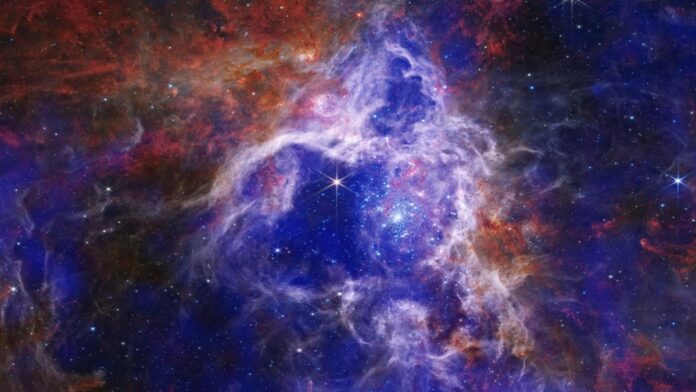NASA’s James Webb Space Telescope and Chandra X-ray Observatory teamed up to provide a stunning new view of the robust star-forming region known as the Tarantula Nebula.
Located only 161,000 light-years away in the Large Magellanic Cloud galaxy, the Tarantula Nebula, formally known as 30 Doradus, is the largest and brightest star-forming region in the Local Group — the galaxies nearest our Milky Way. It is home to the hottest and most massive stars known, which, in turn, helps astronomers better understand how stars are born and evolve.
NASA released a new composite image of the stellar nursery that combines X-ray data from the Chandra X-ray Observatory and infrared images from the James Webb Space Telescope. The detailed new view reveals clouds of gas and dust in the nebula, along with supernova remnants left over from stellar explosions, which serve as the building blocks for the next generation of stars, according to a statement from NASA.
Related: James Webb Space Telescope snaps mind-boggling image of Tarantula Nebula
The royal blue and purple regions of this new mosaic represent the Chandra X-ray data, while the red, orange, green and light blue areas represent Webb observations. The Chandra data captures gas that has been heated to millions of degrees by shock waves generated by the winds from massive stars. The infrared data from Webb reveals baby stars, also known as protostars, as well as cooler gas that provides the raw ingredients for future star formation.
“The chemical composition of 30 Doradus is different from most of the nebulas found in the Milky Way. Instead it represents the conditions in our galaxy that existed several billion years ago when stars were forming at a much faster pace than astronomers see today,” NASA officials wrote in the statement. “This, combined with its relative proximity and brightness, means that 30 Doradus provides scientists with an opportunity to learn more about how stars formed in our galaxy in the distant past.”
While Webb launched just two years ago on Christmas Day 2021, with its first images released in July 2022, Chandra has frequently studied 30 Doradus throughout its 23-year mission. The vast stellar nursery remains an important target for astronomers to observe and analyze.
Follow Samantha Mathewson @Sam_Ashley13. Follow us on Twitter @Spacedotcom and on Facebook.

